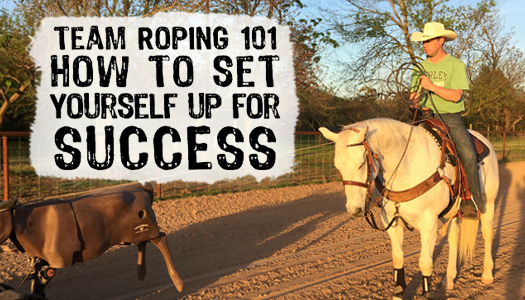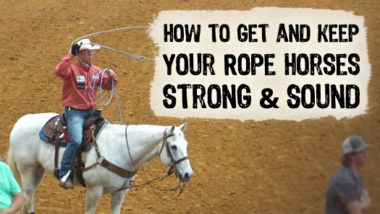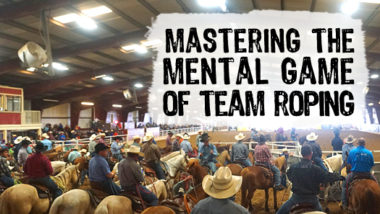Listen to this article in audio form! It’s #9 in the Team Roping Tips Podcast.
For the latest episodes subscribe on iTunes or your favorite podcast app.
Team roping has become one of the fastest growing disciplines of all equestrian sports. The opportunities to win large amounts of money are available for all levels of ropers, with some jackpots offering life changing pay-offs.
It’s not surprising then, that so many people want to be a part of it. However, for someone wanting to get started in team roping, knowing what steps to take (and how, and what order to take them) can be overwhelming.
Getting started off on the right foot, in all aspects, can really speed up the learning curve for beginner ropers. Having high quality tools – such as ropes, roping dummies, horses, and tack help ensure we’re setting ourselves up to be successful. But there’s much more to it than that.
It’s not uncommon for people just getting involved in team roping to focus on their roping first. However, developing our horsemanship and learning to ride, and even train horses well before focusing heavily on roping allows us to understand how & why our horse responds to our cues, where our horse needs to be positioned in a run, and what we as the rider need to do to correct course when necessary. When we become good horsemen first, we can keep our horse working correctly as we develop and fine tune our roping abilities.
Our roping and riding skills are equally important to be successful, but it’s critical to have a firm foundation to build upon. The heighth of our roping success will be largely determined by the depth of our foundation and preparation. We don’t want to put the cart (roping) before the horse. By ensuring we always having the opportunity to get a consistent throw from our horse, we have the best chance to maintain and increase our catch percentage into the future.
HORSE POWER
When it’s time to shop for a head or heel horse, even an experienced rider who is new to roping should ideally start out on an older, solid, dependable horse. The beginning is a critical time to establish correct movement patterns and gain confidence. One that has “been there, done that” will have a lot to teach an inexperienced roper.
There are so many variables and moving parts & pieces that go into an actual run, and even just preparing to practice roping. We want to eliminate as many of the variables as possible and we can do that by starting with a horse we can depend on who literally already ‘knows the ropes.’
The right equine partner can make our break our roping at any level, so take your time when looking for the right match. It’s ideal to try out several horses you can evaluate in order to have some comparison for where your comfort level is, and determine which horse feels the best to you as individuals.
If you feel like you have found a horse that fits you, ask if you can try them at another practice pen or a jackpot roping. You want to confirm before purchase that the horse is solid in various environments.
Getting a pre-purchase exam with a Vet. is a wise common practice to ensure we understand their overall physical condition and whether any specific maintenance is necessary. It’s not uncommon for older, more experienced horses to have had some minor arthritis or evidence of prior injuries. Your Vet. will have the ability to pin point potential red flags that you might otherwise overlook. A Vet. will also be able to explain how any issues a horse has may affect their performance and what might be required to keep them healthy and sound over time.
If the horse you are considering has a history of a past injury or some pathologies, it’s not necessarily a deal breaker. Your decision in this case, is very dependent on the individual horse, your goals, and your willingness and ability to offer that horse the support they need to perform and maintain their well-being. Any extra effort and resources required to keep them at their best may be well worth it. A little additional TLC, careful conditioning, time and expense can go a long way in helping a good horse have a long, happy and successful career.
There are also a lot of great therapy tools out there to help your horses feel great, whether they have certain areas that need support or just to use for recovery and injury prevention. If you budget allows for it, I recommend investing in RevitaVet red light therapy products and an Equivibe Vibration Platform. We use these two modalities in combination on a regular basis.
Routine maintenance and nutritional needs for your horse can also be key to keeping feeling great over the long haul. Joint injections may be indicated at times and regular dental and chiropractic work help keep a horse’s joints, muscles, and entire body performing optimally.
Quality hay combined with feed and supplements can give your horses the nutrients they require to be high performers. A proper diet is key in providing them with the energy they need to make consecutive runs. Towing around a 450 pound steer in deep sand or bringing one to a stop after a 50 meter sprint in the hot sun can really exert a lot of energy. For this reason, it’s also critical that we take steps to always keep our horses properly hydrated as well.
Our horse power can be our biggest asset or biggest liability in team roping, and when our horses are healthy, sound, mentally & physically fit and we’re on the same page through every aspect of our runs, our chances for being consistent and reaching our goals becomes much greater.
ROPING
Although there are more options for lower level ropers today, team roping as a whole has become so much more competitive over the past five to ten years. The days of just needing four smooth runs in the mid-to-longer part of the arena to win a roping are gone.
Now days you still need four smooth runs, but you need to be roping all your steers in the upper third of the arena just to place. It’s an exciting time for team roping, but much more difficult to win than in the past.
One reason is that the competition is tougher is because of the training tools available ropers use to develop the correct movement patterns in their swing and delivery. No matter if you want to be a header or heeler, roping sleds have become so realistic and mimic a real steer so well, allowing us to make repetitive controlled runs – that it only makes sense to invest in and use these tools. I prefer and recommend the Heel-O-Matic line of roping sleds and ground dummies.
Especially as you’re learning to rope, having quality guidance and being able to slow down the process (starting by roping a dummy on the ground) is critical, because it allows us to visualize and make correct, conscious actions in our roping. Taking a little more time in our initial learning phase to enforce the right swing, delivery and position will really put you on the right path to solidifying your fundamentals and build a solid foundation to advance your roping skills on. Investing in a training tool like the Bones Roping Dummy and a Heel-O-Matic is definitely worth the expense for you and your horse, and will provide limitless long-term benefits for your roping.
There are a wide variety of ropes on the market that offer different types of feel. As a beginner team roper, I recommend sticking with a straight nylon rope that is on the softer side in lay – even if you want to focus on heeling (where ropers usually use stiffer ropes). This is because you want to develop feel for your top stand, bottom strand, and tip, and softer ropes make it easier to do this. These parts of our loop each have an important function. It’s important to understand how each part works and determines the way our loop behaves through our swing and delivery. Cactus Ropes offers a wide variety of ropes that fit any level of roper.
Click here to learn more about How to Choose a Rope for Any Occasion.
Another area that is often overlooked is our saddle. It’s important to make sure it fits our horse, but we also want it to fit us. The seat size and contour of the seat have can have an impact on our riding and roping. If a seat is to big, we can slide around, causing our upper body to be out of position. The same goes for the contour of the seat, which impacts the angle of our pelvis. If our hips get shifted forward or back, again our upper body can get out of position.
Typically, if our upper body gets tilted back, the tip of our rope gets pointed upward, away from our target. On the other hand, if our upper body gets shifted forward, even by a small degree – we can lose a lot of power in our swing. Also, anytime our upper body gets shifted out of position, it makes it difficult to give our horse correct, well-timed cues to stop or change direction. There’s really no time in a fast run to regain our position, so we want to invest time in finding a saddle that helps put us and keep us there.
OTHER ASPECTS
Finding a place to practice and getting acquainted with other ropers is a big key in developing your roping.
I watched an interview not long ago from Kory Koontz where he talked about his roping background. One thing that stood out to me was when he said that he didn’t have his own arena until after he had competed at his 19th National Finals Rodeo.
I found it to be a little shocking considering the level or roper he was, and what he has accomplished and is recognized as a great horseman and roper. It just goes to show that if we are determined to be successful, we can find effective and alternate ways to prepare ourselves and our horses no matter what limitations we might face.
Ask around at your local feed store, search or make a post on social media about what you are looking for, or ask folks involved in specific associations if they know of places to rope or people in your area rope with, learn from or even take lessons with. With team roping being one of the fastest growing equine sports, there is no shortage of arenas or people in most parts of the country.
Although team roping offers some large financial opportunities, we need to understand the financial investments to give ourselves the best opportunity to be successful long-term. There are a lot of expenses involved roping. If you’re just getting started, they’re probably much greater than you can estimate right now. For example – diesel fuel, trucks, trailers, ropes, saddles, farrier services, vet bills, entry fees, horse feed, practice cattle, etc.
I recommend having a financial plan (i.e. – making a budget) to ensure you’re ready and prepared to take on all these expenses and maintain them regardless of how much is coming back in the form of winnings. Also ensure the timing is right to really devote yourself. Anything worth doing is worth doing well, and team roping at any level requires serious commitment.
Our time is one of our most important investments we make into our roping. But outside of that, if we don’t have the financial means to cover all the expenses that come with team roping, then we are shortchanging the effort we put into our roping and our success will be short-term or limited. It’s simply not something we want to get into – thinking we can get by or cut corners. We’ll get out of our roping what we put in. It’s certainly something we want to enjoy and do to have fun, but because team roping involves horses, big financial investments, and partners – we also want to take is seriously and approach professionally.
If your funds don’t allow for you to enter competition yet, spend more time in the practice pen sharpening up your roping skills and horsemanship and/or getting the financial end of things in order. That way, when the time is right you’ll be prepared to go forward and give yourself the best opportunity to be successful.
It’s exciting to compete, but the practice pen is where champions are really made. As the saying goes – that’s where gold buckles are won.
It takes time to develop the skills necessary to become consistent in our roping. Learning to team rope, and especially rope well is a process – so decide now to enjoy the entire journey vs. over-focus on the destination, which will actually help make it even more likely that you reach your goals.
If you’d like more support beyond what I shared today, click here to learn about video coaching and be sure you’re subscribed to receive new roping tips when they’re published here at CraigSmithTeamRoping.com.


